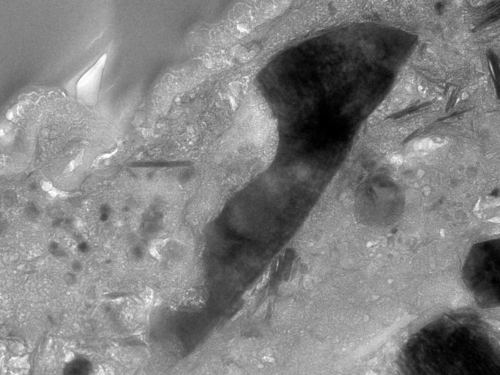Scanning electron micrograph of the number 15 grain of sample plate C0105-042 from Ryugu, in which djerfisherite was discovered. (Hiroshima University/Masaaki Miyahara).
The pristine samples from asteroid Ryugu returned by the Hayabusa2 mission on December 6, 2020, have been vital to improving our understanding of primitive asteroids and the formation of the Solar System. The C-type asteroid Ryugu is composed of rocks similar to meteorites called CI chondrites, which contain relatively high amounts of carbon, and have undergone extensive aqueous alteration in their past.
A research team at Hiroshima University discovered the presence of the mineral djerfisherite, a potassium-containing iron-nickel sulfide, in a Ryugu grain. The presence of this mineral is wholly unexpected, as djerfisherite does not form under the conditions Ryugu is believed to have been exposed to over its existence. The findings were published on May 28, 2025, in the journal Meteoritics & Planetary Science.
“Djerfisherite is a mineral that typically forms in very reduced environments, like those found in enstatite chondrites, and has never been reported in CI chondrites or other Ryugu grains,” says first and corresponding author Masaaki Miyahara, associate professor at the Graduate School of Advanced Science and Engineering, Hiroshima University. “Its occurrence is like finding a tropical seed in Arctic ice—indicating either an unexpected local environment or long-distance transport in the early solar system.”
Bright-field transmission electron micrograph of the djerfisherite inclusion in the number 15 grain of sample plate C0105-042 from Ryugu. (Hiroshima University/Masaaki Miyahara).
Miyahara’s team had been carrying out experiments to understand the effects of terrestrial weathering on Ryugu grains. While observing the grains by field-emission transmission electron microscopy (FE-TEM) for effects of weathering, they found djerfisherite in the number 15 grain of sample plate C0105-042.
“The discovery of djerfisherite in a Ryugu grain suggests that materials with very different formation histories may have mixed early in the solar system’s evolution, or that Ryugu experienced localized, chemically heterogeneous conditions not previously recognized. This finding challenges the notion that Ryugu is compositionally uniform and opens new questions about the complexity of primitive asteroids,” Miyahara elaborates.
Ryugu is a part of a larger parent body that formed between 1.8 to 2.9 million years after the beginning of the Solar System. This parent body is thought to have originated in the outer region of the solar system, where water and carbon dioxide existed in the form of ice. Inside the parent body, heat generated by the decay of radioactive elements caused the ice to melt around 3 million years after its formation. The temperature during this process is estimated to have remained below approximately 50℃.
In contrast, the parent bodies of enstatite chondrites, which are known to contain djerfisherite, are believed to have formed in the inner region of the solar system. Thermodynamic calculations indicate that djerfisherite in enstatite chondrites formed directly from high-temperature gas. In addition, hydrothermal synthesis experiments have shown that djerfisherite can also form through reactions between potassium-bearing fluids and Fe-Ni sulfides at temperatures above 350 ℃.
This led the team to propose two hypotheses for its presence in the Ryugu grain: either it arrived from another source during the formation of Ryugu’s parent body; or, it was formed intrinsically when the temperature of Ryugu was raised to above 350 ℃.
Preliminary evidence indicates that the intrinsic formation hypothesis is more likely to be true. The next steps will be to conduct isotopic studies of this and other Ryugu grains, to determine their origins. “Ultimately, our goal is to reconstruct the early mixing processes and thermal histories that shaped small bodies like Ryugu, thereby improving our understanding of planetary formation and material transport in the early solar system,” Miyahara concludes.
Journal: Meteoritics & Planetary Science
Title: Djerfisherite in a Ryugu grain: A clue to localized heterogeneous conditions or material mixing in the early solar system
Authors: Masaaki Miyahara, Takaaki Noguchi, Akira Yamaguchi, Toru Nakahashi, Yuto Takaki, Toru Matsumoto, Naotaka Tomioka, Akira Miyake, Yohei Igami, Yusuke Seto
DOI: 10.1111/maps.14370

 Home
Home

















